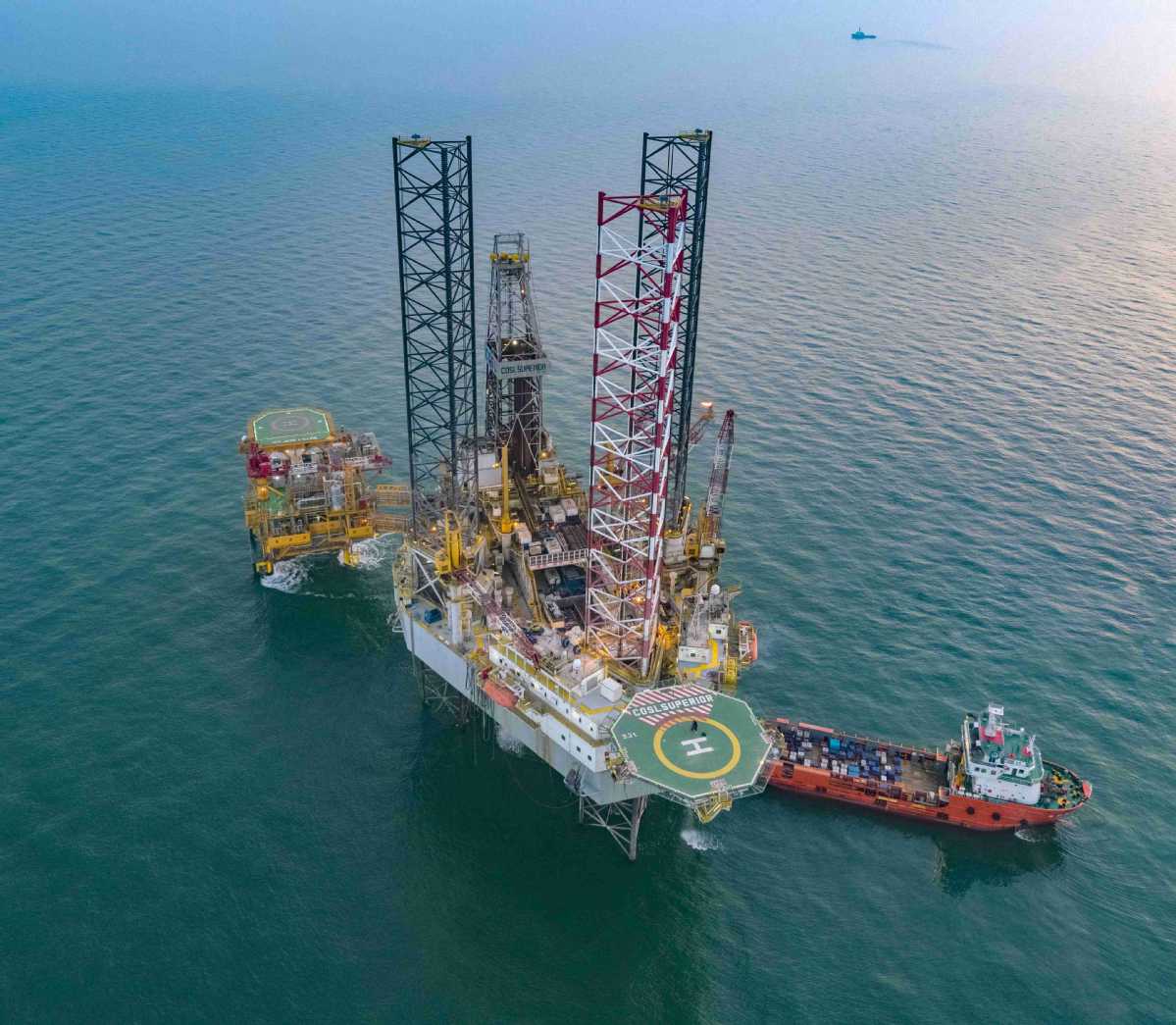China's efforts to bolster energy security took a significant leap forward as its two largest oilfields achieved historic production milestones, underscoring the nation's commitment to enhancing domestic energy supplies amid global uncertainties.

An aerial view of a CNOOC drilling platform in Bohai Bay. [Photo/Xinhua]
China National Offshore Oil Corp (CNOOC) said last Tuesday that Bohai oilfield, the largest offshore oilfield in China, has surpassed daily crude oil production of 100,000 metric tons for the first time since its establishment in 1965 — a cornerstone of China's offshore oil industry.
On the same day, China National Petroleum Corp (CNPC) reported that its Changqing oilfield, China's largest onshore oil and gas field, reached a cumulative output of 1 billion tons of oil and gas equivalent, solidifying its status as the country's most productive onshore oil and gas resource.
Last year, Changqing became the first Chinese oilfield to exceed 60 million tons in annual oil and gas output.
These achievements further enhance the country's energy supply capacity, and are a testament to China's increasing efforts to secure its energy independence in the face of rising geopolitical tensions and fluctuating global oil markets, analysts said.
The milestones achieved by Bohai and Changqing reflect the broader national agenda to enhance self-reliance in energy production and reduce dependency on foreign imports, said Wang Lining, director of the oil market research department of the CNPC Economics and Technology Research Institute in Beijing.
The significant increase in oil and gas production is due to the accelerated investment in domestic exploration, driven by rising energy prices in recent years, Wang said.
China's seven-year action plan for increasing reserves and production of oil and gas has yielded major results in recent years, with the nation's three major oil companies making notable progress through increasing investments, particularly in deep-water, deep-layer and unconventional oil and gas fields.
"China's focus on both onshore and offshore fields further secures energy supply chains and mitigates the risks posed by external factors," he said.
Energy supply in China remained ample and stable throughout last year, with crude oil production remaining steadfast at 200 million tons, marking a sixth consecutive year of growth.
The implementation of economic stimulus policies and the rapid market recovery last year have driven consumption demand for energy such as petroleum and natural gas, said Wu Mouyuan, vice-president of the institute.
According to the institute, oil demand in China is expected to continue rising this year amid economic recovery, while natural gas has been emerging as a pivotal energy source to support domestic energy transition.
Energy self-sufficiency in China continued to rise last year, increasing to 85.6 percent, up 7.2 percentage points compared to the rate in 2016. The robust support of energy supply additions has contributed significantly to economic recovery, it said.
The Bohai Oilfield, with over 50 operational oil and gas fields and more than 200 production facilities, has cumulatively produced more than 500 million tons of oil and gas equivalents. The field is located in the resource-rich but geologically complex Bohai Bay Basin, where ongoing investments are expected to push production to 40 million tons of oil and gas annually by 2025, said Zhang Chunsheng, deputy general manager of CNOOC's Tianjin branch.
The investment will further strengthen offshore oil and gas production's critical role in securing a stable supply of oil and gas resources for China, while reducing reliance on foreign sources, he said.
Changqing oilfield, which began natural gas production in 1997, has been instrumental in supplying over 650 billion cubic meters of natural gas to key regions, including Beijing and its surrounding areas. This volume of natural gas has replaced an estimated 790 million tons of standard coal, contributing significantly to China's carbon reduction efforts.(By Zheng Xin)
About CHINA MINING
China Mining Conference and Exhibition (CHINA MINING) is officially supported by Ministry of Natural Resources China. Since first held in 1999, CHINA MINING has become one of the world’s top mining events and one of the world’s largest mining exploration, development and trading platforms, covering all aspects of the whole mining industry chain, including survey and evaluation, exploration and mining, techniques and equipment, investment and finance, trade and services, etc., playing an active promotion role in creating exchange opportunities and enhancing mutual cooperation between domestic and foreign mining enterprises.
With the theme of "Promote Mining Cooperation for a Better Future", the 26th session of China Mining Conference and Exhibition (CHINA MINING 2024) will be held at Tianjin Meijiang Convention Center of Tianjin China on October 15-18, 2024 in a combination of “offline + online”. Relying on the "Cloud Platform for China Mining Conference and Exhibition ", it will provide the industry and the society with 24-hour uninterrupted information services and realize the "never ending" of the event. CHINA MINING 2024 consists of the opening ceremony, keynote session, summit forums, thematic forums, "offline + online" exhibition, VIP tours, ministerial bilateral talks, BOCI night, welcome party, networking dinner, etc. For more information about CHINA MINING 2024, please visit: www.chinaminingtj.org/en/.



